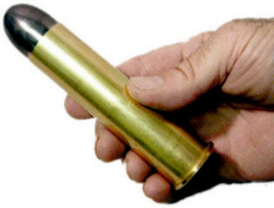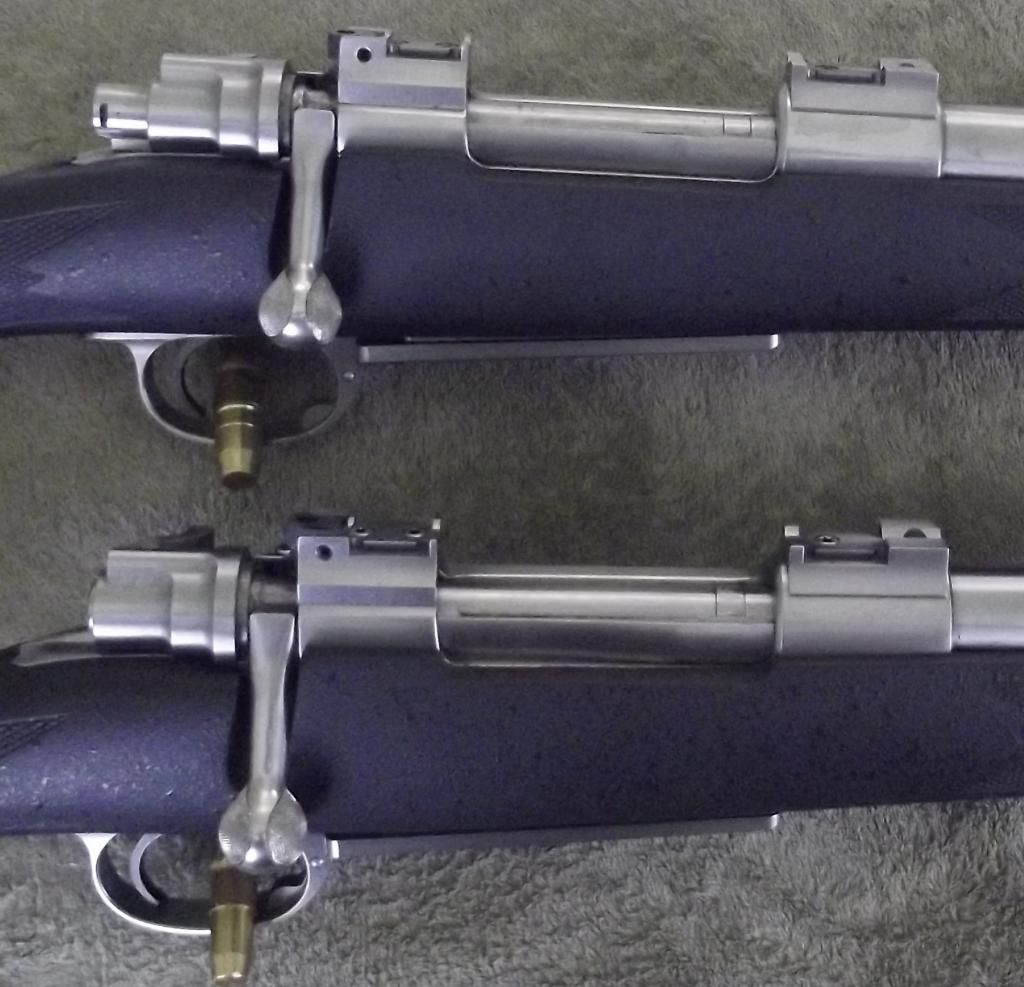

 The Accurate Reloading Forums
The Accurate Reloading Forums  THE ACCURATE RELOADING.COM FORUMS
THE ACCURATE RELOADING.COM FORUMS  Rifles
Rifles  Wildcats And Their Development
Wildcats And Their Development  Ron's Ruger Cats
Ron's Ruger CatsGo  | New  | Find  | Notify  | Tools  | Reply  |  |
One of Us |
This thread is a result of a conversation in the Big Bore Forum’s Ruger basic to 458 Accrel thread. http://forums.accuratereloadin...131085302#9131085302 Here are the pertinent excerpts from that thread:
Jim "Life's hard; it's harder if you're stupid" John Wayne | ||
|
One of Us |
Ron, I don’t know that I’d get quite as “wrapped up” about the need for 0.020”, or 0.022”, minimum shoulder for your cartridge. This is partially the rational I used when I drafted the .500 Ruger 2.65” cartridge/chamber specification back in August 2009. I looked at headspacing off belts – specifically the 470 Capstick - - - Why? Because it has to headspace off the belt due its straight body and as it turned out it’s odd chamber chamfer angle; I figured it’d be a good place to start… The following data is drawn from the SAAMI Cartridge and Chamber Specifications… Cartridge Specifications: Belt Diameter: 0.532” -0.005” – Average = 0.5295” Body Diameter (Belt/Body Junction: 0.5126” -0.008” – Average = 0.5046” Bolt Face through Belt Length: 0.220” -0.008” – Average = 0.216” Mouth Diameter: 0.499” -0.008” – Average = 0.495” Cartridge Length: 2.850” Chamber Specifications: Belt Diameter: 0.534” +0.012” – Average = 0.540” Body Diameter (Belt/Body Junction: 0.5146” +0.002” – Average = 0.5156” Bolt Face through Belt Length: 0.220” (Min) to 0.227” (Max) – Average = 0.2235” Mouth/Chamber Intersection: 0.501” +0.002” – Average = 0.502” Chamfer Angle: 67º22’ Chamber Length: 2.860” +0.008” – Average = 2.864” So here we end up with… Cartridge (Max) to Chamber (Min) Difference: Belt Diameter: -0.002” Body Diameter (Belt/Body Junction: -0.002” Bolt Face through Belt Length: -0.0075” Mouth Diameter: -0.002” Cartridge Length: -0.010” and Cartridge (Avg) to Chamber (Avg) Difference: Belt Diameter: -0.0105” Body Diameter (Belt/Body Junction: -0.011” Rim through Belt Length: -0.0075” Mouth Diameter: -0.007” Cartridge Length: -0.014” and Cartridge (Min) to Chamber (Max) Difference: Belt Diameter: -0.019” Body Diameter (Belt/Body Junction: -0.012” Rim through Belt Length: -0.015” Mouth Diameter: -0.012” Cartridge Length: -0.018” Anyway what all this stuff relates to is that the cartridge belt diameter at the chamber belt/body intersection provides the following headspace: Headspace: Max Cartridge Spec/Min Chamber Spec = 0.0194” total or 0.0097” per side Avg Cartridge Spec/Avg Chamber Spec = 0.0139” total or 0.00695” per side Min Cartridge Spec/Max Chamber Spec = 0.0104” total or 0.0052” per side So based upon the above, a 0.017” Headspace, or 0.0085” per side ought to be good… Which is why I came up with the following (just remember this is the second finish reamer print, the first chamber finish reamer had a 0º30’ throat angle).  The .500 Ruger-2.65” cartridge: .375 Ruger rim and body (at head) specification. Cartridge Length: 2.65” N1/N2 Actuals: 0.522” Comments Added: Originally the finish reamer print had a straighter body with a shoulder, 0.529” diameter at 2.300”, but it was impossible to keep when sharpening the reamer cutting edge. The unfired dummy cases created using the 500 MDM LN (Long Neck) dies created a 0.5265” shoulder at approximately 2.300” on the .375 Ruger Basic Brass – yep a very small shoulder but also very cute! Anyway the original assumption was the combination of the CRF extractor and the almost straight case with the dinky shoulder would secure the case sufficiently to not require using the case mouth as secondary to the primary CRF extractor (the proven concept with the 50 B&M cartridges. And, by using a +0.020” chamber length to the cartridge length, a 45º chamfer angle, plus a 0.490” lead (freebore) gave sufficient overall freebore to allow seating the 550gr and 510gr .500 SST/Lehigh Copper FN Solid bullets (two wide upper bands and a very wide base band) with two upper bands exposed when used in 3.6” magazines – at least that was the rational for the 0.490” lead (or freebore). Unfortunately when redrawing the chamber specifications without the shoulder and changing the chamber angle from 45º to 90º two things were forgotten: 1) change the 0.005” chamber to cartridge clearance specification at the case mouth to a tighter 0.003” clearance specification. 2) change the lead (freebore) from the 0.490” specification to a tighter 0.350” (50 B&M specification) specification. I’ll so both the corrected (updated) chamber specifications with the actual dummy cartridge specifications tomorrow. I’ll post the revised chamber drawing with relating cartridge drawing in a bit… Jim "Life's hard; it's harder if you're stupid" John Wayne | |||
|
| one of us |
Great! Very interesting! Wildcatting is its own reward. Highjack off on the other thread. Got your own thread now to dispay your brilliance. I am following you, not baffled yet ... | |||
|
One of Us |
Edit added to the 2nd post... In blue at bottom. Jim "Life's hard; it's harder if you're stupid" John Wayne | |||
|
| one of us |
Jim, Got it. Thanks. Please don't get loose with the terminology. Parallel-sided free-bore is not leade, and especially not "lead." I am sure you know this but please allow me to clarify in case anyone might happen to read this besides you and I, to prevent confusion. The leade is the angle of taper from P-S free-bore diameter down to bore diameter, or the angle of taper from end of chamber mouth chamfer diameter to the bore diameter in a leade-only throat. The throat's overall effective free-bore is a function of the summation of effects of case maximum length versus chamber minimum length, + chamfer from neck-2 of the chamber to start of P-S free-bore diameter (or start of the leade in a leade-only throat), + length of P-S free-bore, and finally, + the leade + the bullet nose shape/ogive figures into how much jump the bullet has to engagement. Whew! You know that! "Leade": Get the "lead" out. Sorry, couldn't resist. | |||
|
One of Us |
Ron, I’m not arguing over terminologies – But please re-look at the reamer print. I did not generate it from my QD program, or any other program. It is a standard PT&G reamer print annotated with the terminology that they use with dimensional data annotated by Dave Kiff of PT&G relating to my chamber finish reamer. It was emailed to me by PT&G in a pdf format at my request. All I did was use pdf program to generate a jpg copy for inclusion in the thread. Succinctly, it’s their labels, not mine… PT&G labeled “LEAD” as identification of the “Parallel-Sided Freebore” section and “THROAT” as the angled section from the “LEAD/PS-Freebore” to the “Bore” dimension. I simply utilized the labeled terminologies for clarity of anyone reading my comments compared to the PT&G reamer print. And yes a number of us agreed some time back that: “Effective Freebore” = (Chamber Length – Trimmed Case Length) + Chamfer Length/Height + PS-Freebore + (the Length of the Leade from the PS-Freebore Diameter to the Barrel’s Groove Diameter) That said, we must acknowledge that obviously at least one company in the reamer manufacturing business utilizes different terminologies than we’ve settled upon… Jim "Life's hard; it's harder if you're stupid" John Wayne | |||
|
| one of us |
Jim, Confusing usage of terms by Dave Kiff or any reamer maker does not make it right. Dave Manson calls them properly. What are we, barbarians? Leade is proper Olde English terminology. It is the end of the throat, leading from free-bore into the full-bearing rifling. Let us not humor the sloppy. | |||
|
One of Us |
Ron, Not sure that Dave Kiff initiated the terminology; only thing that can be said is that it's PT&G labeled terminology. But I'll certainly make an effort to use the proper words... Jim "Life's hard; it's harder if you're stupid" John Wayne | |||
|
One of Us |
Hey Ron, Finally had a chance to work on your .458 and .475 caliber Rugers using QuickDESIGN and ran into the first interesting issue and it relates to your .458 Ruger dummy case with its mid-neck .488” diameter. Interesting issue arose in that QD indicates an N1/N2 of .4865”/.4855” respectively… Still looking for where I squirreled away my case forming bushing die with multiple size bushings. Sure miss my old storage cabinet… Jim "Life's hard; it's harder if you're stupid" John Wayne | |||
|
| one of us |
Jim, Use N1/N2 of .4865"/.4855". That becomes N1/N2 = .487"/.486" when you round up to nearest .001" which is customary. I was just doing a quick measurement off of one crudely imperfect dummy, no check for concentricity. Reamer N1/N2 minimum then becomes .491"/.490" with the usual +.004" tolerance for chamber minimum. Close enough for preliminaries. | |||
|
One of Us |
Ron, Yes pretty close. If I recollect correctly your 500 Bateleur neck dimensions using the Captech/Jamison basic brass were about 0.004" less at N1/N2 than your 338 LM brass fireformed for your 12.7x68 LM - adjusted for the difference in caliber. Just can't find my notes for the specifics. I want to find my case forming bushing die set so that I can determine whether the basic brass gives the same or slightly thinner neck wall thickness rather than to just rely on the QL algorithm. Upsizing the .416 Ruger to a .458 Ruger is fine but I figure using the basic brass for a .475 Ruger would be better; perhaps even going down to .458 Ruger. Unfortunately I only have .375 Ruger formed brass and .375 Ruger Basic brass, no .416 Ruger formed brass except for a few factory loaded ones. Hum... Just noodling here... Perhaps I'll expand a few of the .375 Ruger formed brass up to .423 caliber and crunch a few of the .375 Ruger Basic brass down to .423 caliber and see how the N1/N2 data matches between the two. That'd be +0.048" and -0.77", definitely ought to show some difference... Anyway back to the reason for this thread... Preliminarily QD gives the .458 Ruger a 108.5grs water overflow capacity and the .475 Ruger a 111.7grs water overflow capacity - both at 3.40" COAL. Jim "Life's hard; it's harder if you're stupid" John Wayne | |||
|
| Powered by Social Strata |
| Please Wait. Your request is being processed... |
|

Visit our on-line store for AR Memorabilia

